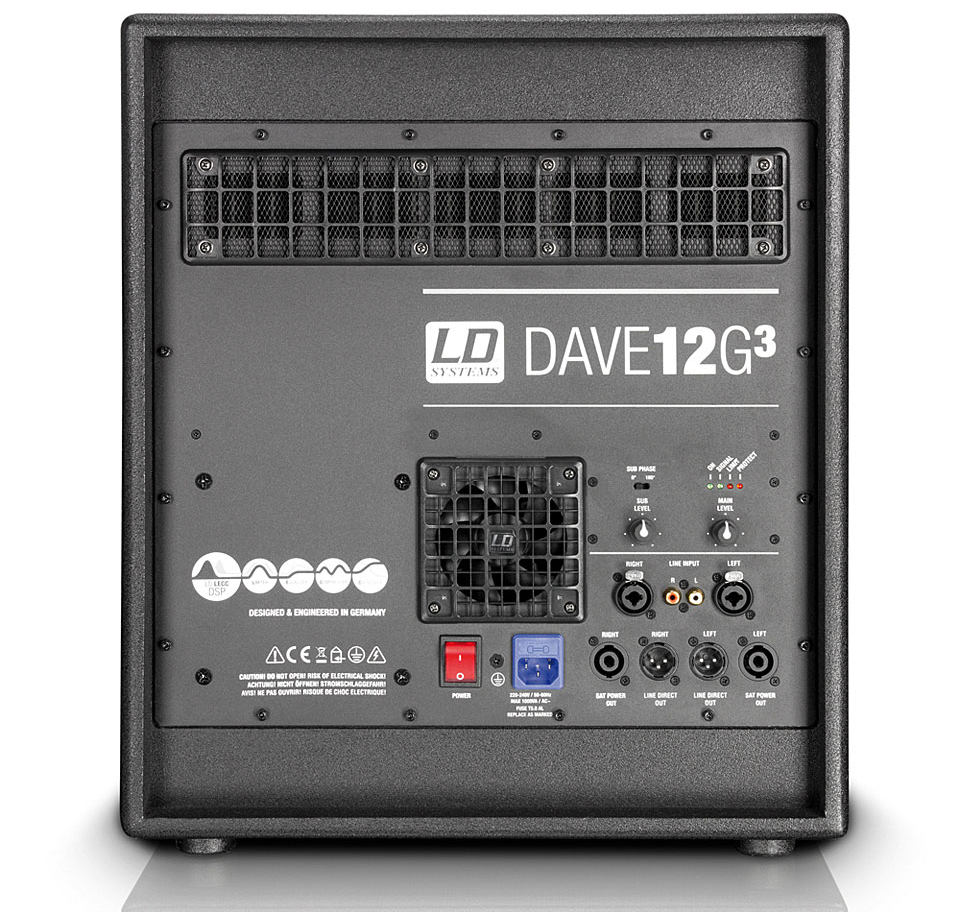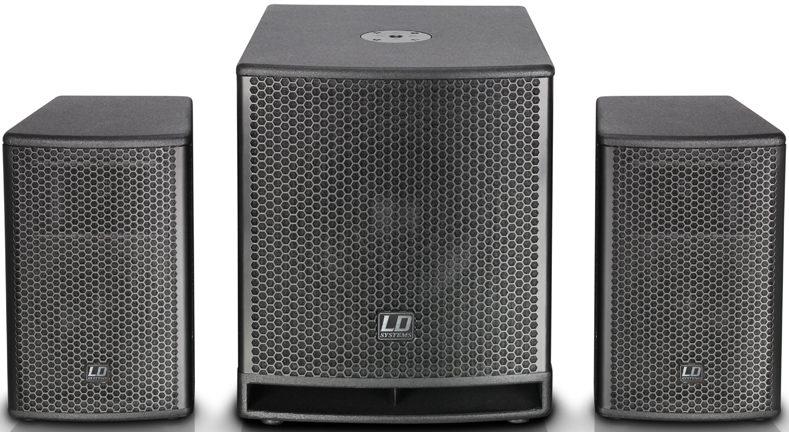The Lowdown
A smart, compact design that offers excellent sound quality for the price, the Dave 12 G3 powered PA system could even be used as your home practise system too – a great all-rounder for small parties.
Video Review
First Impressions / Setting up
This is one of those PA systems where it “all happens” in the subwoofer, with two rather small “satellite” speakers designed to take their inputs via a cable each from the subwoofer. These satellites don’t have their own amplification, just passive crossovers to split the input signal between the two speakers they each contain, and thus they don’t have their own independent audio inputs at all.
The system is designed to always be used as a three-piece, which is why these satellites can be smaller (they only have to cope with the midrange and high frequencies, and only contain actual speakers) and conversely why the subwoofer is relatively bulky and heavy: Not only does it have to provide all the bass “punch” but it also contains the amplifier.
This has advantages and disadvantages: The main advantage is that it is really easy to set up, the main disadvantage being that unlike independently amplified solutions, you need to take all three “boxes” with you everywhere; there’s no option to take just the two satellites for very small gigs. This makes sense in this case because they’d have to be bigger than they are anyway in order to deliver any kind of acceptable bass response on their own; that’s not what they’re designed for.
The look is pure traditional PA: plywood boxes with textured black paint, fine-meshed grills, carry handles and a front-ported subwoofer. The weight and quality are good, especially for the price, and it’s certainly a step up from boomy, hollow-feeling (and sounding) plastic budget PAs.
It’s worth mentioning at this point that there are three models in the range, the 10, 12 and 15; we’re reviewing the middle model, the 12, here. Overall, it feels like you’re getting a lot more PA than you’ve got a right to expect for your money here; sure, it’s relatively compact, but it’s well made, well designed, and rather attractive, albeit in an utterly traditional kind of way.
Setting up
The system is supplied with just a power cable; the two satellites need to be connected to the subwoofer with Speakon cables (a type of PA system cable), which you’ll have to buy separately; bank on buying 2 x 5m cables as a minimum. It is really easy to carry/pick up, with comfortable handles and with the sub, ergonomic finger grips at two different angles to make it easy to be carried either by one person or by one person on each side. The three different angle settings on the satellites work well.
You’ll probably want to invest in speaker stands: The box shows the unit with a single pole coming out of the top of the subwoofer, which splits to hold the two satellites, swivelled apart to provide dispersion (this is an optional accessory). I would suggest for DJ use investing in two more conventional tripod stands would be a better bet, as you could then have more control over the placing of the three boxes depending on the dancefloor you’re wanting to cover.
Set-up involves plugging your source or sources into the available inputs, which are on a panel at the back of the subwoofer. There are L/R balanced combo jack/XLRs and unbalanced RCAs, meaning for instance that you could plug absolutely any DJ controller directly into it. Note it has no mic input and no internal mixer at all, so if you wanted to use microphones or mix more than two sources, you’d need a small PA mixer. Bank on $100-$150 if this is you.

This panel also has the two Speakon sockets to plug the leads that head off to the satellites into, and twin balanced XLR outs, which feed the line-in (ie the same signal you plug into the unit) out to additional amplification/speakers, should that be required. This would easily allow you to plug a monitor in direct from here, should you wish.
Four small LEDs give you a status report; you’re shown power on/off, the presence of an input signal, a limiter, and a protect light. The limiter lights when you’re pushing too much power into it from your music source as a warning, and the protect light indicates the unit has self-muted to protect itself from damage.
In Use
So after plugging literally two leads and the power in, and popping the speakers onto a pair of stands (just above head height is best folks!), you can attach your source, and switch everything the PA on. Took less than 10 minutes.
It is possible to adjust the “balance” between the subwoofer and top speakers, as there are independent subwoofer and main level controls, so you do have some control over the tone. This is useful if you’re not using an external mixer to EQ your room because it allows you to tweak the overall “flat” colour of the sound a little without resorting to using your DJ controller’s EQs. Note that there’s also a phase invert switch for the subwoofer, which may be useful in some circumstances; try it and trust your ears.
We first heard this PA at Musikmesse 2013, where a singer/guitarist was playing through it, and it blew us away for the size, even more so when we found out the price. Of course, amplified dance music is another thing entirely, so we were interested to see how it coped in DJ use. We used it open air on a terrace for about 60 people, tested with a variety of classic dance / pop (The Jacksons / Diana Ross) and current deep house / house (Jamie Jones, Disclosure), and with our own speaker stands (as we said, we reckon an essential extra purchase).
We found a nice sound balance/proportion to be main volume 75% and sub volume 50%. The sound is really crisp and clear, with a nice warm punch to the bass, especially at low “background” volumes the bass is perfectly balanced. The satellites could do with the option to add a bit more top end, but this can be compensated for on the mixer.
The “sweet spot” doesn’t seem to be very wide at all, so unless you are standing/dancing directly in between the two speakers you don’t get the crispness and full range of the satellites. Standing in the DJ position behind the speakers means the sound is pretty weak, as you lose any top-end definition, and so it’s definitely worth using a separate monitor speaker to save you having to “divert” one of the satellites to cover your DJ position. We plugged our monitor into the XLR line out on the LD sub as mentioned above, but most DJ controllers also have a second output you could use.
Overall, it was impressively loud for such a small system, and in the open air, the bass had punch even standing six metres away from the sub. We only pushed the level to 75% in the test yet still got nowhere near testing the limiter and protections built into the system!
It has a crisp full sound which suited all different types of music, even someone singing “happy birthday” in Afrikaans! And again, the clarity and balance of the sub at low levels were fantastic. And as the subwoofer and satellites always “travel together”, this means you’re always going to get the same decent quality out of it if you don’t push it too hard.
As it has a digital signal processor (DSP), this means too that you don’t have to worry too much about setting it up for maximum effectiveness without damaging it: You just plug it in, set the subwoofer and main volumes to roughly equal, and play away. The unit will tell you when you’re pushing it too hard via the LEDs, and built-in compression will treat your audio indiscretions more kindly than if it wasn’t there.
Conclusion
We liked it a lot. Many DJs (semi-pros, part-timers, serious hobby DJs) are never going to spend big on a PA, or play gigs where they need that kind of power. But as we always advise, taking your home speakers to absolutely any party at all, however much you think they are going to cope, is always a supremely bad idea.
Enter the LD Dave G3 series. If the other two systems in the series are anything like the 12 models that we tested today, the three systems all offer an affordable, presentable and capable way of delivering decent sound for any small DJ event.
The LD Dave 12 G3 was easy to set up, pretty foolproof to use, simple to transport, and it sounded good. Such a PA will not only make you appear much more professional than were you to lug some studio monitors out with you but for this price, it is really a no-brainer investment; your first couple of gigs could pay for it outright.

I would have liked to have seen the Speakon cables in the box, as you obviously need them to make it work, and you’ll need stands for the speakers (turning up with a PA and then balancing your speakers on chairs or tables is not practical, safe or professional), but for the price this is acceptable.
With a lovely balanced sound through the whole frequency range, this may not carry the badge, or price tag of some of the more “desirable” PA systems, making it a clever choice for someone wanting to deliver big sound in a small and easily portable package, without breaking the bank.
I’d go as far as to say if you can only afford home monitors or a small PA system for the parties you’re aiming on playing at, you should seriously consider just blowing the cash on say the smaller LD Dave 10 G3, and using that as your studio/practice amplification as well as your playing out PA. As long as there’s room in your practice room for the relatively large subwoofer, you’d be on to a winner!




